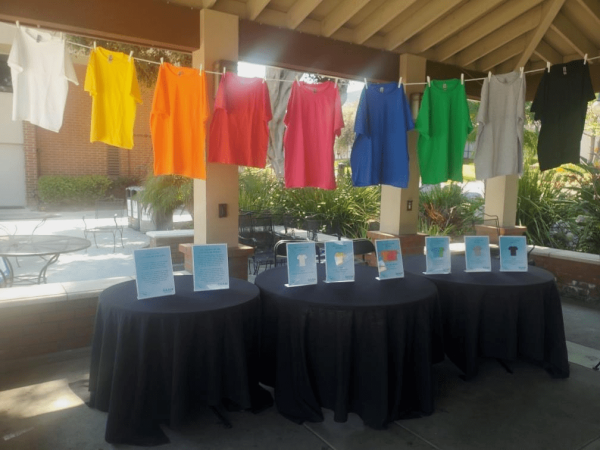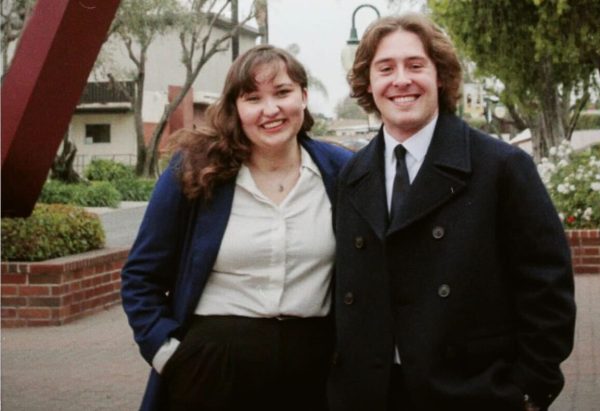Financial programs for students make becoming debt-free possible [Debt Part Three]
Despite the complexity of debt, becoming debt-free is possible.
Students graduating with debt after a Biola University education. | Photo Illustration by Job Ang/THE CHIMES
May 21, 2011
For film grad Andrew Harmon, who received his diploma in May 2010, Biola was worth the cost — at least, at this point, he thinks it probably was.
“The consequences of being in debt, I don’t really know what they are now,” Harmon said.
Harmon’s payments on his approximately $40,000 in student loan debt began New Year’s Day. Aside from a few spurts of employment, Harmon was jobless from graduation in May 2010 until December, when he finally landed a full-time job — miraculously, just in time to start paying off loans.
“They’re not going away fast, but it’s kind of nice to see some of them going away,” he said.
Harmon postponed his Biola experience right out of high school because the prospect of taking out thousands of dollars in loans was too much to swallow. But, after a year of attending a state school in Colorado, he “work[ed] up the nerve” to take out student loans and go to Biola.
Things were looking up for Harmon until 2008, when unfortunate events meant he lost about 60 percent of the money that was supposed to go towards tuition. By the time he graduated in 2010, he had double the amount of loans he had anticipated. Now, with a decent-paying job, Harmon is beginning to chip away at his payments.
“I’ll be handling it like this for a very long time,” he said. “It’s manageable, but still kind of daunting now that all of my money now is still not my own.”
Growing problem of student debt
In six months, the majority of the 650 graduating seniors of the class of 2011 will have student loan payments to face. In 2009, the average Biola senior who borrowed money for school (and 76 percent did) left campus with $26,555 in debt, according to the Project on Student Debt. Nationally, the average amount of debt for the class of 2009 was $24,000.
The number of students carrying debt nationally — and how much they carry — hasn’t always been as high as it is today. In 1993, less than half of students graduated with debt. By 2008, more than two-thirds of graduating students had loans, according to FinAid and Fastweb.
Factors in student debt are complex
The reasons behind the ever-mounting nature of student loans are complex, to say the least. Over the 1980s and 1990s, college costs rose much faster than median income and financial aid. In fact, average college tuition and fees rose 439 percent between 1982 and 2007, while median family income rose about 150 percent, according to the National Center for Public Policy and Higher Education.
In 1980, average college tuition in the United States was $7,579. By 2008, that number had soared to $16,907 and was far higher at private institutions like Biola. While many parents of students currently in college could essentially pay their way through school by working part time or over summers, that option is practically out of the question for current college attendees.
Another factor in mounting debt is a shift from a largely grant-based to a largely loan-based education system. In 1976, the maximum Pell grant award — the grant that covered 986 of Biola’s undergraduate students in the 2008-2009 year, according to the university’s 990 form — covered a whopping 84 percent of tuition costs at public universities around the nation. Although the maximum award for the grant has increased since then, so have tuition costs.
Furthermore, students are taking longer than ever to graduate, which, ironically, is often related to the high cost of college. Longer time in school often translates to more educational debt. In the late 1960s, 46.7 percent of students graduated in four years, according to research by the Higher Education Research Institute at UCLA.
But, according to National Center for Education Statistics data, only 31 percent of students who graduated in 2010 did so within four years. Biola’s graduation rates are notably higher. According to California’s Postsecondary Education Commission data, 53.6 percent of Biola students who started college in 2000 graduated in four years.
Furthermore, families and Americans in general simply are not saving like they have in the past. The fact that Americans are poor savers in general is no secret. In 2006, personal savings dipped into negative territory for the first time since the Great Depression. A 2009 Sallie Mae and Gallup study found that U.S. families saved an average of $2,676 for college annually, for a total of $13,827.
“Loans are a reality for most families,” said André Stephens, director of undergraduate admissions. “It has to be, because most families haven’t saved.”
Stephens said well-meaning families oftentimes have unrealistic expectations about how much financial aid a school can contribute. A 2006 study by Alliance Bernstein’s College Savings Crunch showed that, of the 1,358 parents polled, 75 percent of them were concerned about their ability to save enough for college. At the same time, only 30 percent of them had a financial plan that took into account all their goals, and just one in five had sought help from a financial advisor.
Responsibility is shared
Perhaps inevitably, the question in higher education has become who should take the responsibility for the massive amounts of debt students have accompanying their diplomas. Professionals in higher education, who have become increasingly leery of how Americans are piling on student debt, say the responsibility in paying for school is a shared one among schools, families and students.
“I think sometimes, colleges — they try very hard to show that their college is affordable, so they might feel that it’s in their interest to hide the amount of loans,” said Debbie Cochrane, program director at the Institute for College Access and Success. “The people from the college are the professionals and they do have the responsibility to have the student understand what their options are.”
At the same time, Cochrane added that families and students are responsible for following through with the information handed to them.
Stephens said Biola strives to be up front and honest with students. Cost becomes an increasingly serious part of conversations with students as they get closer to attending. Biola wants to see students succeed, not be disadvantaged because of insurmountable financial burdens.
“We’re not [that] desperate for students,” he said.
Rick Bee, senior director of alumni relations, said that while students and families need to exercise biblical caution, schools — including Biola — need to better educate students about the financial burden they are assuming.
“I think there is a need for greater education with students that are entering school to warn them about the perils of significant debt,” Bee said.
Options out of debt
In efforts to find ways to combat debt, students and schools alike are getting creative.
Some students opt to pay off debt through entering special programs like AmeriCorps or Teach for America, which help pay off student debt. Teaching in a low-income school may also make grads eligible for loan forgiveness.
Teach for America offers programs, though limited, to help capable graduates who want to help low-income, at-risk kids. Over two years, the most a teacher in the program could receive is around $9,500 towards loans. Teach for America also offers loan forbearance programs in which teachers can put off loan payments until after they have completed their time with the program.
“We want to make sure that we have a very diverse core of teachers – that’s why we want to make sure that it’s a feasible option for everyone no matter what their background,” said Kaitlin Gastrock, a spokesperson for Teach for America.
Also, under President Obama’s new initiatives, too, public service loan forgiveness options can clear students of their debt after 10 years, if they devote themselves to public service.
Schools get creative
Some institutions are going the extra mile to make sure students are not drowning themselves in debt. Tidewater Community College in Virginia will require students next fall who want to continue student loans to complete a personal budget worksheet with personal repayment plans.
Other schools, including the University of North Carolina at Greensboro, the University of Washington, Ball State University and Manchester College, are among an increasing number of schools nationwide starting to implement three-year programs to help students graduate with minimal debt.
David McFadden, executive vice president of Manchester College, said finances are a factor in almost every student’s decision to enroll in the school’s Fast Forward program, as students save around $25,000 or more by graduating in three years instead of four.
“Families are increasingly concerned about cost, and this is one of the ways that we wanted to make an option for them,” he said.
Even families who aren’t struggling financially are choosing the program, McFadden said, to save on educational expenses.
“This is a way for them [students] to leave undergraduate school with less debt before heading on to go on to graduate school with more debt,” he said.
Fast Forward’s first class, which enrolled in 2008, graduates this month. But, McFadden said many students in the program have opted out of it because they have found they enjoy college life more than they had anticipated. Patricia Pike, Biola’s vice provost for undergraduate education, said those in Metzger have discussed the possibility of a three-year degree program more than once, but no plans to implement something like that are currently in the works.
Something rather new to the face of Christian higher education, and a concept based off of similar programs at schools like Yale Law School, is the Loan Repayment Assistance Program, which Biola is in the nascent stages of considering at the moment, according to Greg Vaughan, vice president for enrollment management.
Huntington University, a Christian college located in Indiana, is one of several faith-based institutions to use LRAP, which helps reimburse students. Students must graduate, make a salary under a given threshold and need help repaying their loans to be eligible.
Huntington is entering only its third year of the program, but Nate Perry, director of undergraduate admissions at the school, said they have seen slightly higher retention rates thus far, and expect to see even higher ones as time continues. The university expects student satisfaction to increase as well. Huntington is just now preparing to graduate its first class under the system.
“This is not meant to be a lifeline,” Perry said. “It’s not meant for students to live off of this or to be on this until their final debt coupon payment is made. … It’s really just meant to kind of bridge that gap.”
Vaughan said the Affordability Commission, which meets almost weekly at Biola, is considering the LRAP as one of many possible solutions to assisting students financially.
Debt free, finally
When Tiffany Erickson graduated from Biola in May 2008 with a degree in human biology and about $50,000 in student loans to pay back, the prospect of getting out of the red was daunting. Unsure of how to use her degree, she began working as a waitress, paying the minimal amount on her loans with the highest APR.
Not long after, she landed a full-time job with Hawthorn Retirement Group and began making a decent salary. And then, the frugality began. She kept driving her 1993 Toyota. She made sure she was not spending money on unnecessary clothes. She cut out coupons.
“I just made a conscious decision to live off the smallest amount possible,” she said.
Erickson and her husband decided to direct all of her salary towards student loans and live off of his salary alone. After three and a half years, it finally paid off. In March, the couple received a letter with the words “paid in full” on it — all $50,000.
“I was really excited,” Erickson said. “The first thing I did was I made my husband take a picture of me so I could put it on Facebook. … It just felt like a huge burden was lifted.”
Erickson said God’s math has prevailed up to this point.
“I always felt like God always provided,” she said. “We always had more than enough. There was never a time when I felt like were weren’t going to make it.”
And yet, both Stephens and Bee recognized that Biola is not the right choice for everyone. Bee said the initial decision to attend college should not be an assumption.
“So many times, I think students tend to just say, ‘Well, I want to go to college, whatever the cost,’ and they don’t consider the cost,” Bee said. “And I think it’s important to consider the cost — prayerfully.”
Although debt is a reality for the vast majority of students, like it was for Erickson, Stephens said most students find it is worth it.
“Although there is debt, there is also this great appreciation for what Biola has done,” he said.







